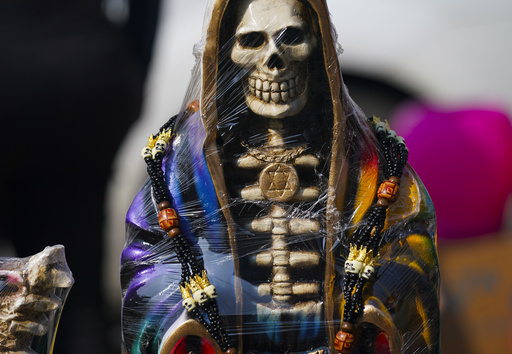
MEXICO CITY — A prominent figure associated with the folk saint cult “La Santa Muerte” was shot and killed at a shrine dedicated to the skeletal figure on Friday night, according to local officials.
Two additional individuals lost their lives, and eight others sustained injuries during the violent incident that took place in León, located in the state of Guanajuato.
Known as “Holy Death,” this saint is frequently venerated by those on the fringes of society, including convicts, drug users, and individuals facing various challenges in life.
Despite not being acknowledged by the Roman Catholic Church, she is typically represented as a female skeleton and is believed to offer protection from death to her followers.
The latest victim, known by the nickname “La Madrina Chayo,” held a significant position within the local cult in Guanajuato.
Authorities did not disclose her legal name, adhering to Mexican privacy laws, but she is also recognized as “Chayito,” a faith healer.
Tragically, she, along with another woman and a young boy, were fatally shot while they were preparing for the annual Santa Muerte festivities.
Immediate details about the status of the eight injured, among them two children, have not been released following the attack at the altar situated on a street corner.
The Santa Muerte is celebrated in a manner similar to Mexico’s Day of the Dead, with observances taking place on November 1 and 2.
In Mexico, Catholic Church leaders have expressed their disapproval regarding the association of the cult with violence and the drug trade.
Often depicted in a black nun’s attire, wielding a scythe, Santa Muerte appeals to followers who seek various forms of assistance, from averting harm and executing revenge to preventing infidelity and securing better job prospects.
Others beseech her for protection of drug shipments and to avoid encounters with law enforcement.
Although the cult may evoke a sense of foreboding, the annual Santa Muerte celebrations tend to be filled with a friendly atmosphere, where participants warmly greet one another and exchange small tokens of affection.
Unfortunately, Guanajuato has faced a persistent issue with violence, sustaining the highest homicide rate in Mexico due to ongoing conflicts between competing drug cartels.
This cycle of violence continues to cast a shadow over communities that seek solace and support through their religious practices.
